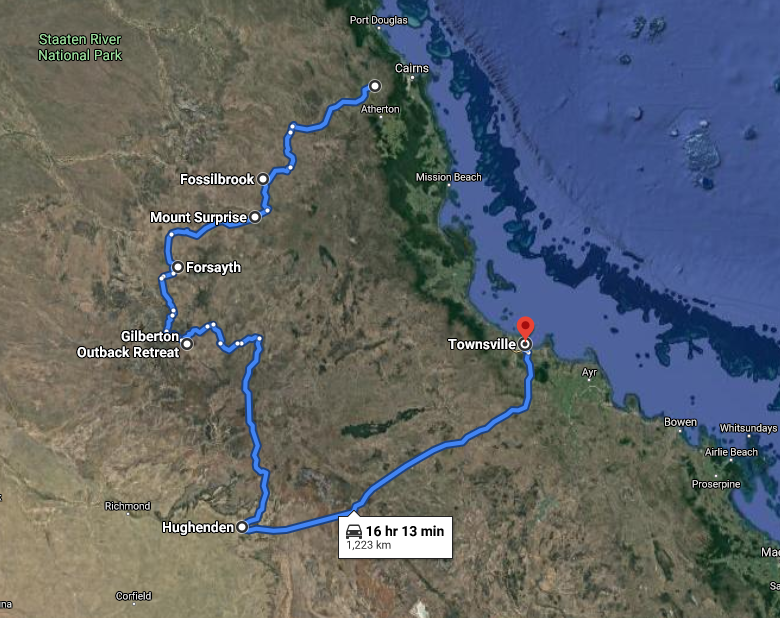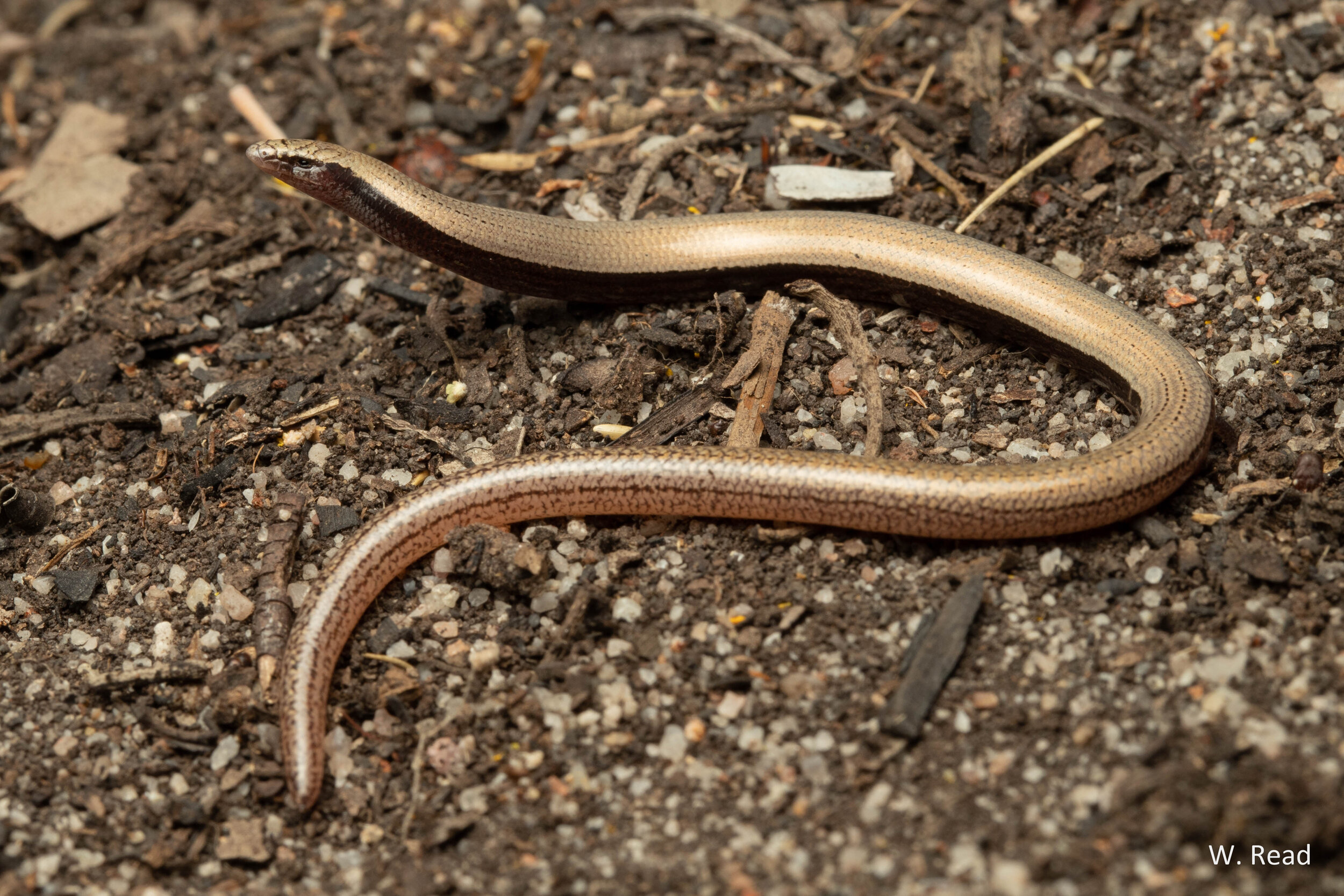The Lerista Trip of ‘21 (Part 2)
Lerista like living down dirt roads.
Townsville to Almaden (16th-20th of June)
Day 6
Leaving the comfort of Justin’s house in Townsville, we turned west for the beginning of our Lerista circuit. First up was the Nubbined Fine-lined Slider (Lerista colliveri), a species that we’d actually looked for on our first north Qld trip without luck. Nick and Justin had managed to find one in the area only a week before though so expectations were high and it didn’t take long for Justin to find a large adult. He also turned up a Dwarf Litter Skink (Pygmaescincus timlowi), a species he’d been chasing for quite a while. Moving further west towards Charters Towers, we dropped into an area for a quick look for the only Lerista species around that I had seen, the Vine-thicket Fine-lined Slider (Lerista cinerea). Successful, a quick celebratory lunch was in order at the esteemed Charters Maccas.
An hour or so later saw us pull up in some lovely open woodland festooned with teddy bears. Egged on by their unsettling presence, it wasn’t long before both Justin and I each found a Hobson’s Fine-lined Slider (Lerista hobsoni). A fast set of photos and we turned tail and fled from the unsettling onlookers. Ditching our Lerista hunt temporarily and investigating rocks I soon spied a flurry of movement as a small Goanna disappeared. Some more investigation turned up both mine and Nick’s first Storr’s Monitor (Varanus storri), although he wasn’t too keen on photos and was soon safely back in his burrow.
The light was fading as we arrived in the bustling township of Torrens Creek, but luckily it wasn’t too far away to the spot for our next Lerista. Despite Justin’s previous experience finding several Two-toed Fine-lined Sliders (Lerista wilkinsi) with ease, the species took a little longer to find than most Sliders we targeted. It couldn’t evade us for too long though and I eventually uncovered a rather golden individual, with Justin also finding a tiny Red-naped Snake (Furina diadema). With our complete success so far, we continued down towards Aramac to see if we could find our 5th Lerista for the day, the Lyre-patterned Slider (Lerista chordae). This species is typically a little harder to find and I wasn’t too hopeful with the dry conditions but spying some seemingly likely trees in the headlights we pulled over to give it a crack. Nick and I set about investigating the dry and dusty leaf litter of some paperbarks while Justin walked a little further along the road. It wasn’t two minutes later and we heard the classic “Got one!” from up the road. A little incredulous, we jogged over to see the 5th target for the day. A little celebration and some photos ensued while we dodged road trains before making our way back to Torrens Creek pub for a beer. Lizard satisfied and thirst quenched, we retreated to the White Mountains to camp.
Day 7
Despite it being the dry season, it decided to rain that night. And not just a sprinkle, it rained quite a lot. Justin had to abandon his roof rack camp and we were all rather sodden the next morning. The leftover clouds also meant our next target, the obscure Red-earth Ctenotus (Ctenotus rosarium) was still safely tucked away in its hidey holes when we gave it a brief search. Justin did manage to turn up another Storr’s Monitor (V. storri) for photos, but that was our only find before continuing our westerly journey. We’d originally given ourselves two days to find all the Lerista we’d managed to find in one, so we decided to use the day exploring Hughenden and then head north.
Arriving at our chosen jump up a few hours later, we set about trying to find a Wide-striped Four-toed Slider (Lerista zonulata). Despite being the most widespread Lerista in north Queensland it proved elusive. We did, however, find several large Sliders that were either Eastern Robust Sliders (Lerista punctatovittata) or Noonbah Sliders (Lerista emmotti) but due not counting toes we couldn’t confirm an id. With nothing else pressing, an executive decision was made to continue out on the black soil towards Winton. Despite dreams of any number of black soil species making an appearance, our short drive was uneventful and after wasting two hours we were back at Hughenden and restocking on dares before turning north.
Queue another couple or so hours of driving and we finally arrived in the little known Blackbraes National Park. We were beginning to lose the light as we set about searching for our next Lerista but it didn’t take long to find several Leaden-bellied Sliders (Lerista vanderduysi). We continued searching for the next few hours in the hopes of finding a Speckled Worm Skink (Anomalopus gowi) but to no avail. A few other species were out and about including Robust Rainbow Skinks (Carlia schmeltzii), Zigzag Velvet Geckos (Amalosia rhombifer), my first new Bynoe’s Gecko (Heteronotia binoei/CYA6-S) lineage and more Leaden-bellied Sliders (L. vanderduysi). A quick detour was also made in the form of a mammal hunt, producing a Northern Greater Glider (Petauroides minor) with minimal effort. Satisfied with our finds, camp was a cold and windy affair amongst the sclerophyll, but at least it wasn’t raining.
Day 8
Before we started heading towards our next destination, one of the places I was most excited to visit for the trip, we had a quick stop the next morning at the Lynd Roadhouse for the three necessities: a pie, a dare iced coffee and a shower, our first since leaving Townsville. Fed, watered and markedly cleaner we were back in the prado and heading onto dirt roads on the way to Gilberton Station. Our primary goal was of course the newly described Gilbert Ground Gecko (Lucasium iris) but there were numerous other species known from the area that were on our radar. Driving in took several hours but we eventually made it and after catching up with the station owners, we arrived at our target outcrop.
We passed the rest of the afternoon exploring some of the sandstone and found several more Leaden-bellied Sliders (L. vanderduysi). After a round of photos we retreated to the car to wait for dark. Conditions began to worsen in the early evening, with temperatures plummeting as we waited nervously for dark. It was unfortunately decidedly chilly by the time we could spotlight and I was worried. We spent the next five hours combing the area but to no avail, the Gilbert Ground Gecko (L. iris) was to elude us, with several Box-patterned Geckos (Lucasium steindachneri) giving me a heart attack everytime I spied one in a burrow. We did manage to track down our other gecko targets with a bit of effort, finding several Silver-eyed Velvet Geckos (Oedura argentea) running around the outcrops in the company of my second new Bynoe’s Gecko (H. binoei/EIU) lineage and some Zigzag Velvet Geckos (Amalosia rhombifer). The isolated population of Northern Phasmid Geckos (Strophurus taeniatus) had also decided it was too cool to climb to the top of their spinifex hummocks, but Nick managed to cunningly find a couple raking. A little disappointed with our failure, I was already planning to return in November as we rolled out our tents and swags for the night.
Day 9
While we’d thought driving into Gilberton Station from the east had taken a while, driving out by the north road to Forsayth took even longer and it was early afternoon by the time we arrived at Georgetown for a burger. Bellies no longer grumbling and ice coffees purchased we headed east for a crack at our next Lerista, the Bulleringa Fine-lined Slider (Lerista alia). Our recon was unfortunately proved shoddy and we eventually found ourselves on some farmers track still a good 25km from our destination. Not wanting to risk going any further, we backtracked out to the highway and decided to leave the species for another time. It would be one of only two Lerista we targeted for the trip that we were unable to find.
Shooting east we arrived at our next location with the sun almost setting. I was absolutely ready to find any form of reptile at this point after spending the entirety of the day in the car, and we all spread out among the granite. It didn’t take me long to find our first, unearthing a Slender Mulch Skink (Glaphyromorphus cracens) among the leaf litter with a bung tail. Spurred on and only a couple of rocks later I had one of only two legless Lerista species in Australia in hand, the Limbless Fine-lined Slider (Lerista ameles). It was only a quick photo session as we had more to do before camp and worryingly, I couldn’t find my headtorch.
After backtracking slightly west and then heading north we arrived at one of the only known locations one could find the Mt Surprise Slider (Lerista storri). After pulling the car to pieces I came to two realisations. One, I was an absolute fool and couldn’t be trusted with anything, and two, I’d left my led lenser where we’d camped the night before at Gilberton. Nice. Donning an old spare head torch of Justin’s that was almost flat, we headed out rakes in hand. I could only see about two foot in front of me. While I was unable to find the Lerista, the head torch did prove itself able to find a previous visitor's toilet paper. Whether they were a casual passer by or a herper shall remain a mystery. Luckily for everyone, Nick proved far more capable and tracked down a large and perfect specimen that was deep in shed.
We had one more target to find that night and after only driving a few more kilometres north we stopped at a pullout surrounded by rock. After giving the car one more futile search for my head torch and the others a head start, I headed into the rock using my phone torch, which was somehow brighter than the spare headtorch. Stumbling and falling across the rock I soon came across two baby Amber Rock Dtella (Gehyra electrum), far too small to put us through the frustration of photographing. Nick once again came up with the goods shortly after and following some quick photos we made camp at a nearby creek.
Day 10
Continuing on towards the next morning Almaden we had one more Lerista species to target, the Chillagoe Fine-lined Slider (Lerista parameles) and having camped nearby, it didn’t take us long to arrive at the spot. Finding it did take a little longer but a baby Freckled Monitor (Varanus tristis) and several Northern Bar-lipped Skinks (Eremiascincus isolepis) kept us occupied until Nick once again produced the little squiggler. Another round of photography ensued as we came to the realisation that we’d just blitzed through ten Lerista species in just over four days, not a bad effort. As this brings to a conclusion the original round of targets for the trip, I’ll cut this entry here and continue the rest of day 10 in the next one.


























